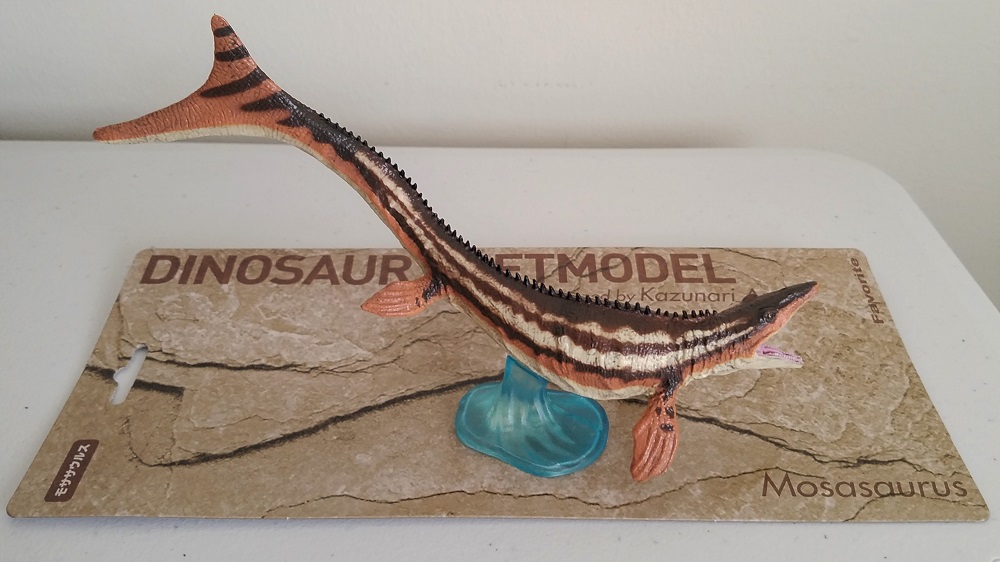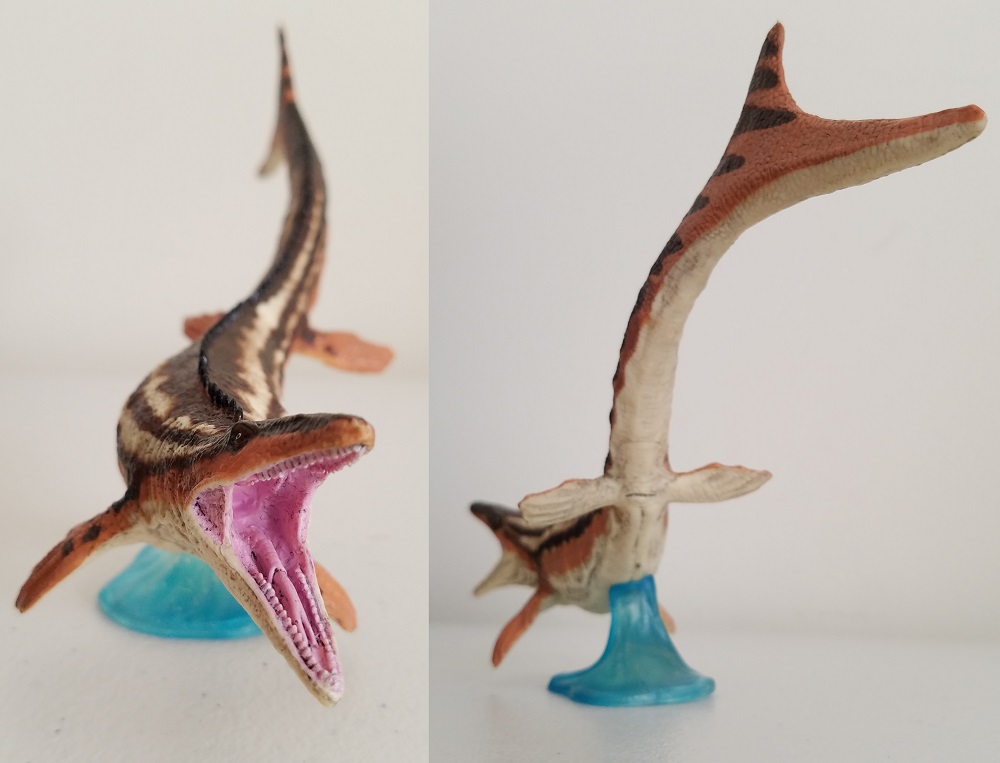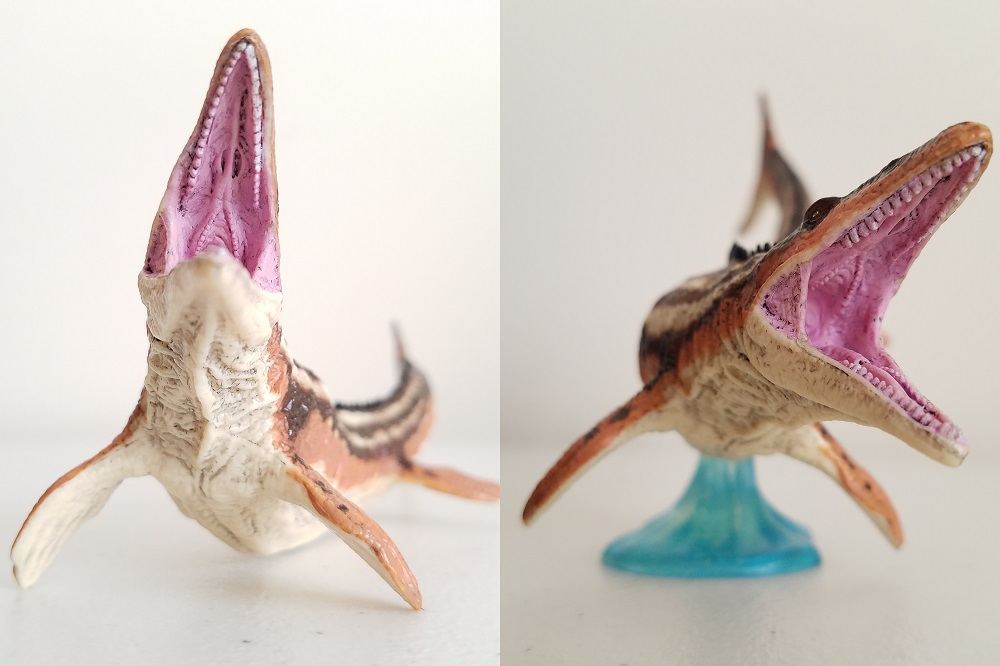Kazunaki Araki’s sculpt reflects how our scientific understanding of Mosasaurus has changed, while retaining more classic, retro traits in appearance.
Dinosaurs have often been compared to modern lizards, perhaps because they tend to be a default image the general public has of reptiles. In fact, dinosaurs were only very distantly related to lizards; but while they were dominating the land throughout the Mesozoic era, a genuine branch of the order Squamata began conquering the seas during the Cretaceous. Known as mosasaurs, these long, muscular predators are thought to have belonged somewhere beside modern monitors and snakes in the family tree, and were among the most powerful predators in the Cretaceous waterways, with the genus Mosasaurus hoffmannii itself thought to have reached 17 meters (56 ft) in length. Although a fairly regular staple in prehistoric iconography, Mosasaurus received a fresh bump into stardom in 2015 with the release of Jurassic World, and toy companies have been continuing to produce new iterations of the animal over the years.

Favorite Co. Ltd. of Japan tends to run at a different pace than other, more worldwide brands. After a few busier years of assorted wide and exclusive releases, 2019 was fairly quiet for the company. However, they did decide to update their Soft Model “Dinosaur” line with the inclusion of their take on the great “Meuse River Lizard.” Designed by Kazunaki Araki, Favorite’s leading dino sculptor, Mosasaurus comes packaged in the standard cardboard and plastic slip which includes the regular company information as well as facts regarding the animal itself (primarily in Japanese, of course). Mosasaurus is perhaps one of the larger figures in the series, measuring roughly 9 inches (23 cm) long—although this puts the figure at less than 1:54 or even 1:70 scale based on the real life estimated sizes of 12.5-18 metres provided on the packaging. A small base is included, decorated as a translucent blue plume of water, which is inserted into the Mosasaurus’ belly.

The animal is posed “as if it were diving deep under the sea to catch ammonites or fish,” as Kazunaki Araki himself describes in comments on Favorite’s main website. With its mouth agape, and its body snaking downward, the figure appears quite dynamic, and can be viewed from most angles with attractive results.

Our scientific understanding of Mosasaurus has changed more than what some popular culture depictions would suggest (which should not be surprising for seasoned enthusiasts and collectors). Favorite’s soft model reflects certain recent findings, but in other ways seems rather “retro” in appearance. In a short interview available on Favorite’s product page for the figure, Araki comments that he struggled between constructing the model based on current scientific findings or more classic, nostalgic renditions (even considering the addition of claws on the flippers). Ultimately, he went for a compromise between the two in design, resulting in a fairly unique rendition of the animal.

Probably the most obvious new trait of the Mosasaurus is the inclusion of a large, lobed tail fin raised dramatically in the model’s diving/attack pose. In the last decade, evidence has pointed to mosasaur tails having sturdy, crescent-shaped flukes, rather than the traditional slender eel tail pervasively seen in depictions over the decades. The ventral lobe on this figure is considerably large, making up nearly half the full length of the tail, which seems consistent with current skeletals. Such a large tail would have undoubtedly provided great strength in ambushing or pursuing prey, to an extent that the old-fashioned eel shape could not possibly provide for a predator of Mosasaurus‘ size.

At the opposite end of the figure, the head is rich with detail to survey. The skull matches the sturdy, triangular shape known from fossil remains, and the position of the eyes and nostrils appear closely aligned in proper place—although the eyes do appear smaller and more raised than what may have been likely. Two circular cavities are present behind the eyes, but are inconsistenly positioned; it’s hard to tell if this is the parietal or squamosal section of the skull. The teeth are modestly sized and mostly uniform, but are all individually sculpted, even to the small pterygoid teeth in the back (although, the pterygoid itself appears to be backwards in arrangement). The internal nares, part of the nasal structure, are also visible on the roof of the mouth, and a forked tongue, slightly extended, rests in the lower jaw. Araki comments he included a forked tongue to reflect the presence of a Jacobsen’s organ, a sensory organ which is present in many modern-day animals, but particularly developed in lizards and snakes. Overall the mouth is very fleshy and organic-looking, giving the figure additional dramatic presence when viewed from the angle of its gaping maw.

Running the length of the backbone is a single row of black glossy spikes, similar to structures seen in iguanas and water dragons. It’s another stylistic choice which gives the figure a more aggressive profile rather than a scientifically-informed one. Older reconstructions of mosasaurs would often depict the animals with shallow soft-tissue “frills” or sails, but current fossil evidence doesn’t support this idea much, if at all; the popular fringed appearance stemmed largely from misidentified throat tissue. A row of hard, protruding spikes might have been even more problematic, possibly cutting into the animal’s swimming efficiency, which would have been critical for a predator like Mosasaurus.

In a similar manner, the figure’s skin is highly textured with scales and skin wrinkles, along with prominent folds and wattles around the neck and along the length of the flanks. It’s very enjoyable to handle in person with so much detail, but once again it’s not very reflective of current science. Knowledge of mosasaur skin is still limited, but most of Mosasaurus’ body would likely have been covered with tiny scales that would be invisible at model scale (this is also true of dinosaurs, and is often a choice of compromise that manufacturers and sculptors must make between strict realism and product attractiveness), with exceptions in a few places such as the flippers and fluke. The flippers are reasonably proportioned, although the individual digits look more pronounced than necessary to me. The soft model is generally on the skinnier side; the chest region is reasonably robust, but not to the more pronounced barrel-chested extent seen in current reconstructions. Thankfully, this figure doesn’t appear to be so much a victim of the shrink-wrapping which often befalls Araki’s sculpts, as much as it is naturally slim in a manner reminiscent of modern-day lizards. Araki himself acknowledges that Mosasaurus likely would have had a smooth body texture, more befitting a streamlined marine predator, but he chose to depict wrinkly, scaly skin to express the animal’s relationship to the aforementioned monitor lizards of today.

Coloration for the model comes in conservative brown and dull orange, with dirty cream stripes running the length of the body and a solid light underbelly. Araki states he chose colors with patterns that resemble terrestrial monitor lizards and fish, and the result is effectively eye-catching without being as vividly colored as some of Favorite’s other models. The large stripes on the upper body contrast in a way that might have been impractical for a large predator—sharp striping might have affected camouflage in the water—but it’s a well-applied color scheme at the very least. The mouth is colored bright pink and a black wash has been applied to both the mouth and the belly to highlight the finer sculpt details. The result is effective, but also gives the figure a rather dirty appearance. Perhaps the figure would have benefitted from a more carefully-applied or modest application.

Kazunaki Araki cites Mosasaurus as one of his favorite prehistoric creatures, and I think it shows in this soft model toy. It isn’t really going for a strictly scientific rendition; rather, it’s a stylized take on the animal, applying modern touches to a more old-fashioned, nostalgic image of the animal. It’s a deliberate choice which might turn off some collectors, but kids are sure to love how dynamic this mosasaur looks, and personally I think it’s a cool figure which succeeds in its stylization better than a lot of other figures who try similar concepts. Favorite’s soft model Mosasaurus comes recommended by me. Sadly, many of their more recent figures are trickier to obtain in the States. If you want to avoid being scalped on eBay, the figures are pretty easily found on Amazon Japan. Just be mindful of shipping costs.
Support the Dinosaur Toy Blog by making dino-purchases through these links to Ebay and Amazon. Disclaimer: links to Ebay.com and Amazon.com on the Dinosaur Toy Blog are often affiliate links, when you make purchases through these links we may make a commission

Nice article. It is one of my favorite figures of non-dinosaur animals from Favorite, the colors contrary to what the author says seem very attractive to me and I honestly do not care about those dirty paint colors, for me they make that extinct marine reptile from the end of the Mesozoic more interesting.
It’s a great little figure for sure and worth hunting down. My only wish was hoping it was bigger.
Great review.
Excellent review. I quite like this figure, and I struggle to think of a Mosasaurus that I like better at the moment, aside from the PNSO one perhaps.
Excellent review, very thorough. Thanks for including the commentary from Araki himself. I keep hoping for Favorite to make one of Japan’s own marine reptiles, like Futabasaurus, Phosphorosaurus, or Utatsusaurus.
Some Japanese marine reptiles would certainly be welcome – although, knowing the company’s track record, such figures would probably be rare museum exclusives or something like that. They’d probably look quite nice, at least!
Ugh, you’re probably right. In their main dinosaur line, they do tend to choose species very conservatively.